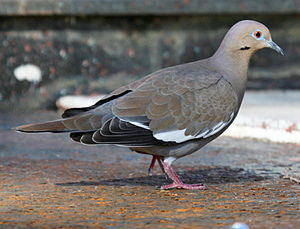White-winged pigeon
| White-winged pigeon | ||||||||||
|---|---|---|---|---|---|---|---|---|---|---|

White-winged pigeon ( Zenaida asiatica ) |
||||||||||
| Systematics | ||||||||||
|
||||||||||
| Scientific name | ||||||||||
| Zenaida asiatica | ||||||||||
| ( Linnaeus , 1758) |
The white-winged pigeon ( Zenaida asiatica ) is a species of pigeon birds . It occurs in several subspecies in southern North America, the Caribbean, and Central America. The species is not threatened. The population in the United States alone is estimated at 530,000 white-winged pigeons.
Appearance
The white-winged pigeon reaches a body length of 28 centimeters. It is a little bigger than a laughing dove. It has a longer beak and longer wings compared to this species. The gender dimorphism is only weak. The females are only slightly more dull in color than the males.
The plumage on the head, neck and chest is a warm, light brown. The skull and neck are tinged with pink. Both behind the eye and below it there is a narrow, dark stripe. The most striking feature of the discrimination Mourning Dove and the eared dove is the white band at the outer edge of the wing. The wings of the hand are dark black-brown. The belly and rump are light gray. The tail is graduated. The outer tail feathers end with a wide, white band. The beak is dark gray. The iris is orange-red. The dark circles are featherless and blue-gray. The feet are reddish.
distribution and habitat
The former northern limit of distribution of the white-winged pigeon was southern California , southern Arizona , southern Texas and southwest New Mexico . It has spread northward in Texas and New Mexico. Oklahoma , Louisiana , coastal areas of Mississippi , Kansas, and Arkansas were repopulated. It was human settled in Florida and Alberta . In Mexico, the white-winged pigeon is only absent in the humid southeast. In Guatemala it is absent in the north. In Honduras , it is absent on the north coast and in some eastern regions. The southern limit of distribution of the species runs through Panama . It colonizes the Bahamas , Cuba , Jamaica , Hispaniola and Puerto Rico , the Cayman Islands , San Andrés and Providencia , among others . It is relatively rare in the Virgin Islands .
The habitat of the white-winged pigeon are arid and semi-arid habitats. It inhabits open grasslands, scrubland and open forests from the coastal plain to altitudes of 2,700 meters above sea level. Cities have also been settled in recent decades. It is also found in mangrove swamps from Mexico to Costa Rica.
behavior
The white-winged pigeon is a migratory bird in the north of its range. In the south it is a resident bird. It eats seeds and small fruits that it looks for on the ground. The breeding time depends on the respective distribution area. In the north of its range, the white-winged pigeon breeds in spring and summer. In the south of its range, however, it breeds all year round.
Parts of the population breed in colonies. The nest is usually three to eight meters high. The clutch consists of two cream-colored eggs. The incubation period is 14 days. The young birds fledge after 13 to 16 days.
Keeping in human care
White-winged pigeons were first introduced to Europe in 1901 and were successfully bred as early as 1902. Unlike the other mourning pigeons , it does not play a major role in European wild pigeon keeping and is rarely kept.
supporting documents
Individual evidence
literature
- David Gibbs, Eustace Barnes, John Cox: Pigeons and Doves - A Guide to the Pigeons and Doves of the World. Pica Press, Sussex 2001, ISBN 90-74345-26-3 .
- Alois Münst, Josef Wolters: Pigeons - The types of wild pigeons. 2nd, expanded and revised edition, Verlag Karin Wolters, Bottrop 1999, ISBN 3-9801504-9-6 .
- Gerhard Rösler: The wild pigeons of the earth - free living, keeping and breeding. Verlag M. & H. Schaper, Alfeld Hannover 1996, ISBN 3-7944-0184-0 .
Web links
- Zenaida asiatica inthe IUCN 2013 Red List of Threatened Species . Listed by: BirdLife International, 2012. Retrieved September 7, 2013.